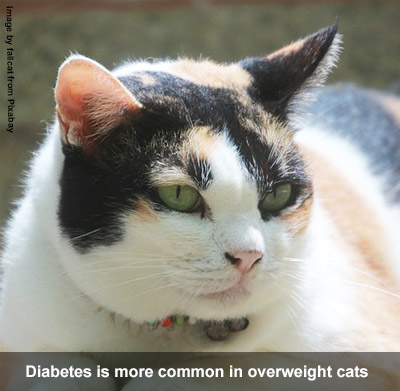You’ve found out that your cat is diabetic and now you’re wondering what this means for you and your pet. This page covers the key points that every diabetic cat owner should know, to help you feel more confident in your ability to keep your feline family member healthy and happy.
What is Feline Diabetes?
Diabetes in cats is not that different from diabetes in people. Diabetes (AKA diabetes mellitus) refers to a problem with regulating blood sugar (glucose). Insulin helps the body to use glucose for energy, and store the rest. Diabetic cats either don't produce enough insulin or have a resistance to it. There are two main types - type I and type II. Type I diabetes is rare in cats, type II is far more common.
What causes diabetes in cats?
 The cause of diabetes in cats tends to be a complex interaction of multiple risk factors.
The cause of diabetes in cats tends to be a complex interaction of multiple risk factors.
Overweight cats are four times more likely to develop diabetes, the same is true for Burmese cats when compared to other cat breeds. Older cats, particularly neutered males, are also more prone to developing diabetes. Additionally, cats on steroid treatments are at higher risk of developing diabetes.
What are the symptoms?
The symptoms of diabetes in cats are as follows:
- Increased urination and drinking
- Weight loss
- Tiredness
- Increased appetite
- General weakness
Also take note if your cat strains to urinate or passes blood in their urine, as diabetic cats are more prone to urinary tract infections. If you suspect your cat may be diabetic, it is important to arrange a health check straight away. Your vet will be able to diagnose diabetes using a blood test and a urine test as well. Diabetes is usually treatable, but requires patience and commitment.
How is Feline Diabetes Treated?
Daily insulin injections will normally be required to manage the condition, along with a carefully monitored diet.
Although treatment is generally lifelong, a small proportion of cats will go into diabetic remission once treated, meaning that the cat is cured of diabetes. This is uncommon though, and about 30% of cats who achieve diabetic remission will relapse later down the line. With proper care and management diabetic cats can often live into their teens with a good quality of life, so a diagnosis of diabetes is definitely not cause for despair!
What does looking after a diabetic cat involve?
Injections
The main form of treatment for diabetic cats involves giving the cat once or twice daily insulin injections at home. This can seem a little daunting at first but it is a simple skill to learn, and most cats tolerate this treatment very well.
It’s important to have a routine timeframe when giving these injections, however the exact time of day can vary slightly each day. Your vet can give you tailored advice about this, and provide the help you need to get started.
Vet visits
Another aspect of caring for a diabetic cat is regular trips to the vet. If your cat has only just been diagnosed with diabetes, then this may require more vet visits initially, to find an appropriate dosing regimen for your cat. Once the cat is stable, as the owner you can assess your cat’s condition at home via the use of a blood glucose monitor - again, something your vet will be able to discuss with you. From here, vet visits won’t need to be as frequent, although the vet will still want to see your cat on a regular basis to monitor his health.
Diabetes diary
It’s recommended that you keep a ‘diabetes diary’ to track how well the diabetes is being managed over time. Some good examples here from iCatCare of what to include in your diabetes diary. A diary is also useful for your vet to assess how well your cat’s diabetes is being controlled, and if there’s anything that needs improving.
Lifestyle changes
A diabetic cat requires certain lifestyle changes. For example, your diabetic cat will need a low carbohydrate diet to help maintain a healthy weight. Diets low in carbohydrates also help to stabilise blood sugar levels and prevent them from spiking after eating.
Weight management
Long-term management of diabetes also involves careful monitoring of weight. Obesity plays a major role in feline diabetes, so it’s important that an overweight diabetic cat is encouraged to lose weight at a safe rate. This can be done by feeding a low carbohydrate diet (as mentioned above) or by encouraging exercise. More information here about how to help your cat maintain a healthy weight.
Routine
Routine is essential for a diabetic cat. Diabetic cat owners need to commit to regular monitoring and treatment procedures to ensure the condition is controlled. You may want to consider keeping your diabetic cat indoors or installing cat fencing or a catio in your garden to ensure they get their insulin at the correct time and prevent them from accessing other food sources. However, every cat is unique, and it may be best to seek further advice on this from a vet or the rehoming centre where you adopted your cat.
What if complications occur?
Every now and again, a diabetic cat will become unstable because his insulin requirements may change over time. For example, for those cats that do achieve diabetic remission, giving further insulin may cause low blood sugar levels (hypoglycaemia). If you suspect your diabetic cat is hypoglycaemic you should contact your vet immediately. Find more information here about hypoglycaemia and other diabetic cat emergencies - but if in doubt speak to your vet straight away.
The return of diabetic symptoms is also a good indicator of diabetes not being under control. Although this situation doesn’t necessarily class as an emergency, you should still get in touch with your vet promptly to prevent further complications from occurring.
What if I want to go on holiday?
You can! As long as you leave your cat in the care of someone you trust. Most boarding catteries and pet sitting services will be experienced with diabetic cats, and will administer injections as an additional service (usually at a small extra cost). If a friend or family member is to be entrusted with monitoring your cat and giving their injections while you’re away, ideally this person would be experienced, have some knowledge of dealing with diabetic cats, and know when veterinary help might be needed.
Diabetic cat in a multi cat household?
Any dietary changes should be checked by a vet, however it’s quite possible to feed all cats in your household on a ‘diabetic diet’ without causing harm. You will need to monitor how much food your diabetic cat is eating though. Owners of multi cat households should be aware that a diabetic cat may require more support than the other cats in the house.
Give food at consistent times in a diabetic cat household to maintain routine and make sure insulin injections are given at the optimum time. If necessary, cats should be separated during mealtimes, with separate food bowls containing the specific amount of food for each cat.
Could you adopt a diabetic cat?
Please do! It is estimated that as many as 1 cat in 200 develops diabetes at some stage of their life. Inevitably therefore, rescue centres will from time to time take in a diabetic cat for rehoming.
The time and cost commitment of owning a diabetic cat is not something to take lightly, however if you are someone capable of meeting the needs of a diabetic cat then we strongly encourage you to do so. Their special requirements mean that diabetic cats often spend a long time in rescue centres waiting for their forever home. However, diabetic cats have just as much love to give as any other, and with the right owner and veterinary guidance can go on to live long and happy lives.
Please contact your local rehoming centre if you'd like to give a diabetic cat the chance of a loving home.
The vast majority of people who care for diabetic cats master the task of administering insulin injections within a few weeks. If you are diabetic, you may already be used to this, and could be the perfect companion to a furry friend with the same condition!
Key take home messages
- A consistent routine is essential.
- Most cats require lifelong monitoring and treatment, but this is very possible to provide with a willing owner.
- Always contact your vet if you’re worried about anything to do with your diabetic cat.
Further Advice
 Advice and support from Your Local Veterinary Practice
Advice and support from Your Local Veterinary Practice
Cat Chat Vet Adviser: email This email address is being protected from spambots. You need JavaScript enabled to view it.
Cats Protection guide to Feline Diabetes (downloadable PDF): www.cats.org.uk/diabetes.pdf
Feline Diabetes website: www.felinediabetes.com
International Cat Care: Feline Diabetes Mellitus
Main contributor: Lauren Bates, veterinary student, under the supervision of Dr Joanna Woodnutt MRCVS of The Veterinary Content Company. Thanks also to Jenny Stavisky MRCVS BVM&S PhD, University of Nottingham School of Veterinary Medicine and Science for additional information, and to The AHAA (American Animal Hospital Association) for their 'How to Administer Insulin to your Cat' video.


